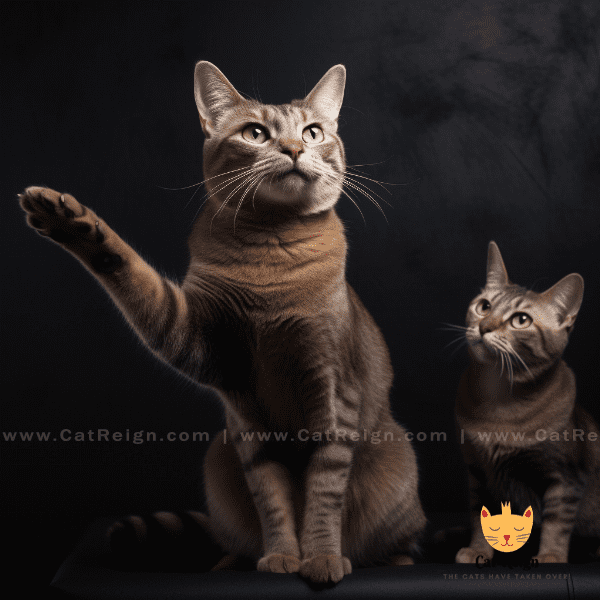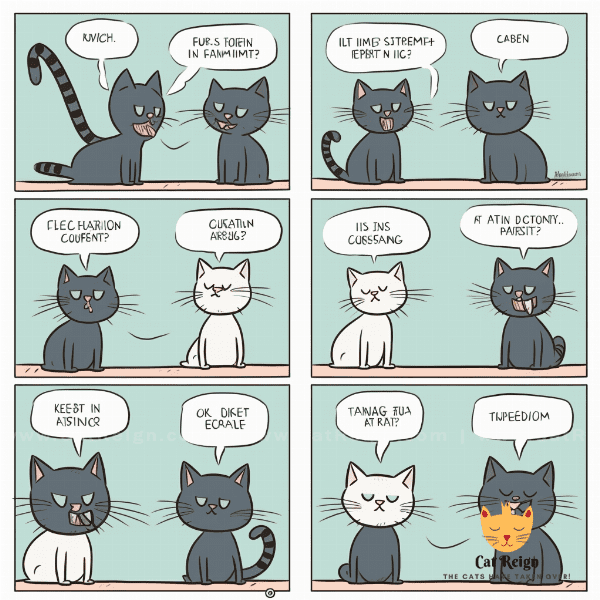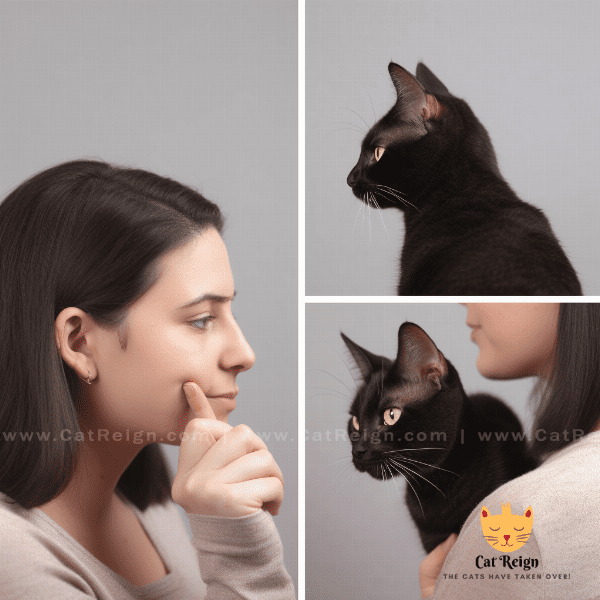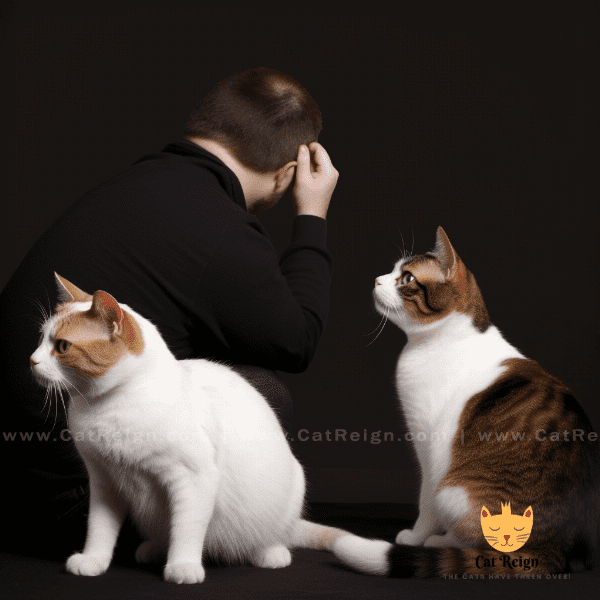Table of Contents
- Understanding the Importance of Feline Communication
- How Cats Use Their Ears to Communicate
- The Different Positions of Cat Ears and What They Mean
- Reading Other Feline Body Language Cues Alongside Cat Ears
- Common Misconceptions About Cat Ears Language
- Helping Your Cat Communicate Better with You through Understanding Their Ears
- Tips for Interpreting Cat Ears Language in Different Situations
- Communication Breakdown: What to Do When You Don’t Understand Your Cat’s Ears
- Communicating with Other Cats: Using Your Own Ears to Better Understand Feline Language
- Conclusion: Building Stronger Relationships Through Feline Communication.
Understanding the Importance of Feline Communication
Cats are fascinating creatures, and their unique way of communicating is one of the most interesting things about them. Feline communication is a complex system that involves a variety of sounds, body language, and behaviors. By understanding and interpreting these signals, you can better understand your cat’s mood, needs, and desires.
Strengthening the Bond between You and Your Cat
One of the most significant benefits of understanding feline communication is that it can help strengthen the bond between you and your cat. When you learn to interpret your cat’s body language and vocalizations, you can respond appropriately to their needs and desires. This can make your cat feel more secure and loved, which, in turn, can lead to a stronger bond between you and your pet.
Promoting a Positive Environment for Your Cat
Feline communication can also help promote a positive environment for your cat. By understanding what your cat is trying to communicate, you can respond in a way that meets their needs and avoids any potential sources of stress. This can help your cat feel more relaxed and comfortable in their surroundings, which is crucial for their overall well-being.
Preventing Misunderstandings and Conflict
One of the most common reasons for conflicts between cats and their owners is a lack of understanding about feline communication. Cats often communicate in subtle ways that can be challenging for humans to understand. By learning to recognize and interpret these signals, you can prevent misunderstandings and conflicts with your cat. This can lead to a more harmonious relationship between you and your pet.
Conclusion
Understanding feline communication is an essential part of being a responsible cat owner. By learning to interpret your cat’s signals and respond appropriately, you can strengthen the bond between you and your pet, promote a positive environment, and prevent misunderstandings and conflict. By taking the time to understand your cat’s unique way of communicating, you can build a happier, healthier relationship with your feline companion.

How Cats Use Their Ears to Communicate
Cats have a wide range of body language cues, and their ears are one of the most expressive parts of their body. By paying close attention to your cat’s ears, you can learn a lot about what they are thinking and feeling.
An Overview of Cat Ears
Before we dive into how cats use their ears to communicate, it’s important to understand a little bit about the anatomy of a cat’s ear. A cat’s ear is made up of three parts: the outer ear, the middle ear, and the inner ear. The outer ear is the visible part of the ear that we see on the side of a cat’s head. The middle ear contains the eardrum and the three tiny bones that transmit sound vibrations to the inner ear. The inner ear is responsible for processing sound and maintaining balance.
The Different Positions of Cat Ears and What They Mean
Cats can move their ears in a variety of ways, and each position can convey a different message. For example:
- Ears Forward: When a cat’s ears are pointing forward, it usually means that they are alert and interested in what is going on around them. This position can also indicate excitement or curiosity.
- Ears Back: When a cat’s ears are flattened against their head, it usually means that they are feeling scared or threatened. This can be a warning sign that your cat is feeling defensive and may lash out if they feel cornered.
- Ears to the Side: When a cat’s ears are pointing to the side, it usually means that they are feeling relaxed and comfortable. This can be a good sign that your cat is feeling happy and content.
The Importance of Ear Movements
In addition to the position of their ears, cats also use ear movements to communicate. For example, a cat may swivel their ears to pinpoint the source of a sound, or they may flick their ears back and forth to show annoyance or frustration.
Conclusion
Cats use their ears to communicate in many different ways. By paying attention to the position and movements of your cat’s ears, you can learn a lot about what they are thinking and feeling. Understanding how cats use their ears to communicate is an essential part of building a strong, healthy relationship with your feline companion.

The Different Positions of Cat Ears and What They Mean
As we mentioned earlier, a cat’s ears are one of the most expressive parts of their body, and the position of their ears can convey a lot about what they are feeling. In this section, we’ll take a closer look at some of the different positions of cat ears and what they mean.
Ears Forward
When a cat’s ears are pointing forward, it usually means that they are alert and interested in what is going on around them. This position can also indicate excitement or curiosity. For example, if your cat hears a noise in another room and their ears perk up, it’s a sign that they are paying attention to what’s happening.
Ears Back
When a cat’s ears are flattened against their head, it usually means that they are feeling scared or threatened. This position can be a warning sign that your cat is feeling defensive and may lash out if they feel cornered. If your cat’s ears are back, it’s best to give them some space and avoid doing anything that could escalate the situation.
Ears to the Side
When a cat’s ears are pointing to the side, it usually means that they are feeling relaxed and comfortable. This can be a good sign that your cat is feeling happy and content. If your cat is lying on their side with their ears in this position, it’s a sign that they are feeling very comfortable and at ease.
One Ear Forward, One Ear Back
Sometimes, a cat may position one ear forward and one ear back. This can be a sign that they are feeling uncertain or conflicted. For example, if your cat is trying to decide whether to approach a new object or person, they may position one ear forward to show curiosity while positioning the other ear back to show caution.
Conclusion
The position of a cat’s ears can convey a lot about what they are thinking and feeling. Understanding the different positions of cat ears is an important part of interpreting feline body language and communicating effectively with your pet. By paying attention to your cat’s ears and other body language cues, you can build a stronger, more fulfilling relationship with your feline companion.

Reading Other Feline Body Language Cues Alongside Cat Ears
While a cat’s ears are one of the most expressive parts of their body, they are not the only body language cue that cats use to communicate. In this section, we’ll explore other feline body language cues that you can read alongside cat ears to better understand what your cat is trying to tell you.
Body Posture
A cat’s body posture can also convey a lot about their mood and intentions. A relaxed, open posture with their head held high indicates that the cat is feeling confident and comfortable, while a hunched, defensive posture indicates that they are feeling scared or threatened. By observing your cat’s body posture, you can get a better idea of how they are feeling and whether they are comfortable in their environment.
Vocalizations
Cats use a wide range of vocalizations to communicate, from meows and purrs to hisses and growls. By paying attention to your cat’s vocalizations, you can get a better idea of what they are trying to communicate. For example, a purring cat is usually a happy cat, while a hissing or growling cat is usually a scared or angry cat.
Conclusion
Reading other feline body language cues alongside cat ears is an important part of understanding feline communication. By paying attention to your cat’s tail position, body posture, and vocalizations, you can get a better idea of what they are feeling and how to respond to their needs. By learning to read your cat’s body language, you can build a stronger, more fulfilling relationship with your feline companion.

Common Misconceptions About Cat Ears Language
Feline communication is a complex system, and there are many misconceptions about how cats use their ears to communicate. In this section, we’ll explore some of the most common misconceptions about Cat ears language.
Misconception #1: Ears Always Indicate Mood
While a cat’s ear position can convey a lot about their mood, it’s important to remember that other factors can influence their ear position as well. For example, a cat may move their ears to pinpoint the source of a sound, or they may flatten their ears in response to a sudden noise or movement. It’s essential to take the entire context into consideration when interpreting a cat’s ear position.
Misconception #2: One Ear Position Means the Same Thing in All Cats
While some cat ear positions, such as flattened ears, are universally understood to convey fear or aggression, other positions can vary from cat to cat. For example, one cat may hold their ears forward when they are curious, while another may hold their ears back in the same situation. It’s important to learn your cat’s unique ear language rather than assuming that all cats communicate in the same way.
Misconception #3: Ears Are the Only Body Language Cue to Consider
While cat ears are one of the most expressive parts of their body, they are not the only body language cue that cats use to communicate. As we discussed earlier, a cat’s tail position, body posture, and vocalizations can also convey a lot about what they are feeling. It’s essential to consider all of these factors together to get a complete picture of your cat’s communication.
Conclusion
There are many misconceptions about cat ears language, and it’s important to remember that feline communication is a complex system that involves a variety of cues. By taking the time to learn your cat’s unique ear language and considering all of their body language cues together, you can better understand what they are feeling and how to respond to their needs. By building a deeper understanding of feline communication, you can strengthen the bond between you and your feline companion.

Helping Your Cat Communicate Better with You through Understanding Their Ears
As we’ve discussed, understanding your cat’s ear language is an essential part of feline communication. By learning to read your cat’s ear positions and movements, you can better understand what they are feeling and how to respond to their needs. In this section, we’ll explore some tips for helping your cat communicate better with you through understanding their ears.
Tip #1: Pay Attention to Your Cat’s Ear Positions
The first step in understanding your cat’s ear language is to pay close attention to their ear positions. Observe your cat in different situations and note how their ear position changes. Over time, you’ll begin to develop an understanding of your cat’s unique ear language.
Tip #2: Consider the Context
As we mentioned earlier, it’s essential to consider the context when interpreting your cat’s ear positions. For example, a cat with their ears back may be feeling threatened, but they may also be preparing to pounce on a toy. By considering the entire context, you can get a more accurate picture of what your cat is feeling.
Tip #4: Use Positive Reinforcement
Finally, it’s essential to use positive reinforcement to encourage your cat to communicate with you. When your cat uses a specific ear position to communicate a need or desire, respond positively by meeting that need or desire. Over time, your cat will learn that they can communicate with you effectively through their ear language.
Conclusion
Understanding your cat’s ear language is an important part of building a strong, healthy relationship with your feline companion. By paying close attention to your cat’s ear positions and movements, considering the context, responding appropriately, and using positive reinforcement, you can help your cat communicate better with you. By building a deeper understanding of feline communication, you can strengthen the bond between you and your cat and provide them with the best possible care.

Tips for Interpreting Cat Ears Language in Different Situations
Interpreting cat ears language can be challenging, especially in different situations. In this section, we’ll provide some tips for interpreting cat ear language in various situations to help you communicate better with your feline companion.
Tip #2: During Grooming
During grooming, a cat’s ears may be pointed forward, indicating that they are enjoying the attention. However, if your cat’s ears are flattened or twitching, it may be a sign that they are uncomfortable or in pain. In this case, it’s best to stop grooming and check for any signs of injury or discomfort.
Tip #4: During Mealtime
During mealtime, a cat’s ears may be pointed forward or slightly to the side, indicating excitement and anticipation. However, if your cat’s ears are flattened or twitching, it may be a sign that they are feeling stressed or anxious. In this case, it’s best to ensure that your cat has a quiet, comfortable space to eat and is not being disturbed during mealtimes.
Conclusion
Interpreting cat ears language can be challenging, but by paying close attention to your cat’s ear positions and considering the context, you can get a better understanding of what they are feeling and how to respond to their needs. By following these tips for interpreting cat ear language in different situations, you can build a stronger, more fulfilling relationship with your feline companion.

Communication Breakdown: What to Do When You Don’t Understand Your Cat’s Ears
Despite our best efforts, there may be times when we don’t understand our cat’s ear language. In this section, we’ll explore some tips for dealing with communication breakdowns and improving your understanding of your cat’s communication.
Tip #1: Consider Other Body Language Cues
If you’re having trouble interpreting your cat’s ear language, it’s essential to consider other body language cues as well. For example, if your cat’s ears are flattened, but their tail is wagging, it may be a sign that they are feeling playful rather than aggressive.
Tip #3: Seek Help from a Professional
If you’re still having trouble understanding your cat’s ear language, it may be helpful to seek help from a professional. A veterinarian or animal behaviorist can provide guidance and support in interpreting your cat’s communication and improving your relationship with them.
Tip #4: Be Patient and Persistent
Improving your understanding of your cat’s ear language takes time and patience. Don’t get discouraged if you don’t see results right away. Keep observing and interacting with your cat, and over time, you’ll develop a deeper understanding of their communication.
Conclusion
Communication breakdowns can be frustrating, but by considering other body language cues, observing your cat in different situations, seeking help from a professional, and being patient and persistent, you can improve your understanding of your cat’s ear language. By building a deeper understanding of feline communication, you can strengthen the bond between you and your feline companion and provide them with the best possible care.

Communicating with Other Cats: Using Your Own Ears to Better Understand Feline Language
Understanding feline communication isn’t just about interpreting your own cat’s ear language. It’s also about being able to communicate with other cats effectively. In this section, we’ll explore how you can use your own ears to better understand feline language and communicate with other cats.
Tip #1: Observe Other Cats’ Ear Language
When interacting with other cats, it’s essential to observe their ear language closely. Note how their ear positions change depending on their mood and the environment. Over time, you’ll develop a better understanding of how different cats communicate through their ear language.
Tip #2: Respond Appropriately to Other Cats’ Ear Language
Once you’ve learned to read other cats’ ear language, it’s essential to respond appropriately. For example, if a cat’s ears are flattened, it’s best to give them space and avoid doing anything that could escalate the situation. If a cat’s ears are forward, it’s a sign that they are interested in something, so you can try playing with them or showing them a new toy.
Tip #3: Use Your Own Ears to Communicate
Just as cats use their ears to communicate, you can use your own ears to communicate with them. For example, by making soft, purring sounds, you can convey that you are friendly and non-threatening. By hissing or growling, you can communicate that you are feeling scared or threatened.
Tip #4: Be Patient and Respectful
Finally, it’s essential to be patient and respectful when communicating with other cats. Remember that cats are individuals with their own unique personalities and communication styles. By observing and responding appropriately to their ear language, using your own ears to communicate, and being patient and respectful, you can build positive relationships with other cats.
Conclusion
Understanding feline communication is an essential part of communicating with other cats effectively. By observing other cats’ ear language, responding appropriately, using your own ears to communicate, and being patient and respectful, you can build positive relationships with other cats and provide them with the best possible care. By building a deeper understanding of feline communication, you can strengthen the bond between you and your feline companions.

Conclusion: Building Stronger Relationships Through Feline Communication.
Feline communication is a complex system that involves a variety of cues, including ear language, body language, and vocalizations. By learning to read your cat’s ear language and considering the context, you can better understand what they are feeling and how to respond to their needs. In this article, we’ve explored the importance of feline communication, how cats use their ears to communicate, the different positions of cat ears and what they mean, reading other feline body language cues alongside cat ears, common misconceptions about cat ears language, tips for interpreting cat ears language in different situations, what to do when you don’t understand your cat’s ears, and communicating with other cats.
Through these tips and techniques, you can build a stronger, more fulfilling relationship with your feline companion. By paying close attention to your cat’s communication and responding appropriately, you can provide them with the best possible care and strengthen the bond between you and your feline companion. Remember to be patient, respectful, and observant when communicating with your cat, and always seek help from a professional if you need it.
In conclusion, by building a deeper understanding of feline communication, you can provide your cat with the love, care, and attention they need to thrive. Feline communication is a beautiful and complex system, and by taking the time to learn your cat’s unique ear language and communication style, you can enjoy a deep and rewarding relationship with your feline companion.




